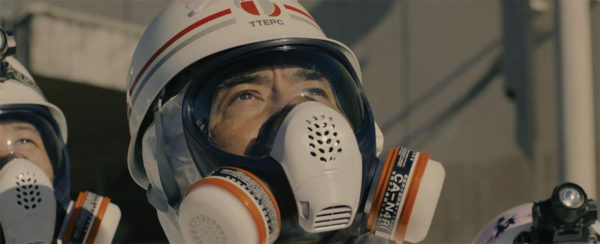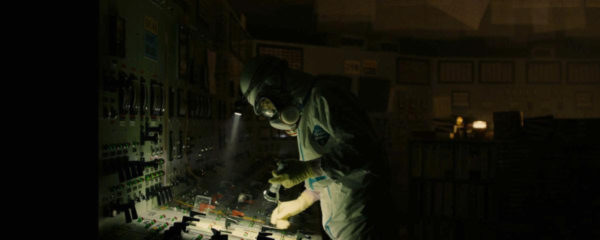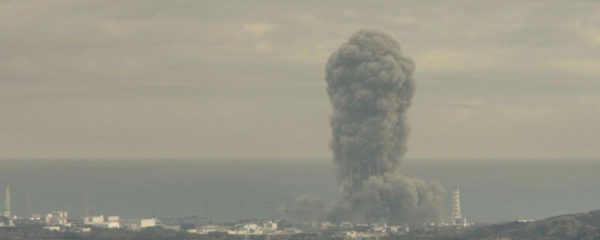
Fukushima 50 offers a glimpse at the environmental and political elements that nearly contributed to a catastrophic nuclear disaster in Japan in 2011.
Setsuro Wakamatsu’s film begins almost immediately with a magnitude 9.0 earthquake off the coast of Japan that causes a tsunami that envelops the Fukushima Daiichi nuclear power plant, which was built lamentably close to the water because no one believed it was susceptible to damage. The resulting water damage causes a blackout, which allows the reactor to begin melting down and prompts a mass evacuation of residents. It also nearly causes the deaths of the men who work diligently to try and stave off disaster. Fukishima 50 is their story.
The film covers the approximately 90 hours that follow as catastrophe after catastrophe cripples efforts to regain control of the situation. Yoichi Maekawa’s screenplay, adapted from Ryusho Kadota’s book “On The Brink: The Inside Story of Fukushima Daiichi”, struggles early on to balance the need to chronicle each new horrific development with the audience’s need to invest in characters. Unlike American disaster films, Maekawa does not attempt to humanize the drama until nearly the halfway point of the film; instead the focus is on establishing the geographical layout of the plant, the nearby seismic isolation centre and the bureaucratic chain of command that disrupts (and exacerbates) the situation.

Ultimately two main characters emerge: Toshio Izaki (Kôichi Satô), who leads the men at ground zero, and Masao Yoshida (Ken Watanabe), the put-upon mediator in the seismic isolation centre who butts heads with the off-site idiots at HQ and the Prime Minister’s office. Izaki is the emotional center of the film: it is his men who are continually put in danger from increasing levels of radiation and, mid-way through the film, the character attempts to mend a rift with his adult daughter in anticipation of his death.
Yoshida’s role is more assertive and, in some ways, more intriguing. He’s basically the middle man caught between the low-level workers and the political mucky-mucks who don’t know what’s going on. Watanabe is the most internationally recognizable actor in the film and while Yoshida doesn’t have a backstory of note, Watanabe does a great job selling his character’s frustrations as he repeatedly pushes back against the political spin that’s jeopardizing his co-workers’ lives.
There’s a fascinating panopticon effect as Yoshida and his employees, who are close enough to the explosions to be at risk of radiation exposure, are literally surveilled by the bureaucrats in HQ, who watch them on a live-feed and communicate with Yoshida via microphone. There’s a clear judgment, even condemnation, in Maekawa’s script of everyone in authority, particularly Yoshida’s HQ boss Kazuhiko Fukuhara (Tomorô Taguchi) and, most gallingly, Japan’s Prime Minister (Shirô Sano) who comes off as inept, abusive and out of touch.

Problematically, by the time that Izaki and Yoshida come to the foreground, their backstories and emotional beats disrupt the flow of Fukushima 50. The film never manages to balance these brief scenes of character development (often portrayed via flashback) with the more traditional “Disaster Movie” moments as the power plant threatens to explode.
This is especially obvious as the film progresses. Fukushima 50 has a lengthy two hour run-time that struggles with pacing, in part because of real life developments that make the narrative feel repetitive. Still, there are several opportunities that could be trimmed down, the most egregious of which is the unnecessary introduction of American soldiers and politicians who are stationed in Japan. Not only are these not characters in the film, but key moments with these non-entities wind up feeling artificially inserted and at odds with the Japanese cast and story. This is especially galling when none of these characters contribute to the narrative in a meaningful way.
Audiences who are accustomed to Hollywood disaster movies will likely find Fukushima 50’s resolution underwhelming – primarily because it lacks a heroic moment and a sacrifice, but mostly because the narrative portends inevitable doom, then resolves itself miraculously and without bombastic explosions. As a result, Fukushima 50’s “climax” and conclusion feels a touch muted.

A set of pre-credit cards explain the moniker that gives the film its title and offers a little exposition about the real men portrayed in the film, though it feels brief and doesn’t offer a cathartic sense of closure. Oddly, as the credits roll, images of the real life construction of Fukushima Daiichi plant transition into idyllic pictures of children playing in water and other unrelated imagery that would not be out of place in a tourism guide for Japan. It’s a bizarre disconnect from the events preceding it, one of several tonally off creative decisions that appear throughout the film.
The Bottom Line: Fukishima 50 is a fascinating glimpse at the environmental and political elements that nearly contributed to a catastrophic nuclear disaster in Japan. Unfortunately the film struggles to balance its plot and its characters, resulting in pacing and tone issues, particularly in its back half. 3/5
Fukushima 50 is now available on Blu and DVD.